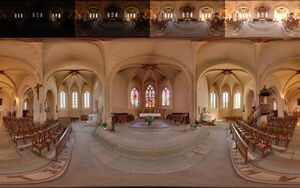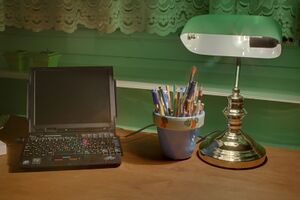Enfuse
Enfuse is a command-line program used to merge different exposures of the same scene to produce an image that looks very much like a tonemapped image (without the halos) but requires no creation of an HDR image. Therefore it is much simpler to use and allows the creation of very large multiple exposure panoramas.
Enfuse is based on a paper by Tom Mertens, Jan Kautz and Frank Van Reeth: "Exposure fusion" The implementation was done by Andrew Mihal (developer of Enblend) and the hugin team around Pablo d'Angelo
State of development
Enfuse is currently in beta and available with the development version of Enblend from panospace.wordpress (scroll down on that page).
Known bugs
- Windows version only: if used on too many and/or too large files enfuse terminates with an error message:
an exception occured [...] unable to create image swap file
- - fixed in version linked above
- If used on images with unaligned alpha mask (result of aligning handheld shots) there might be colored or dark spots.
- Workaround: crop the aligned images.
- - fixed in version linked above
- If contrasty structures are near zenith or nadir in an equirectangular image, there might be an artifact (vortex) in the resulting pano.
- Workaround: use on zenith and nadir images separately and stitch them in the resulting pano afterwards.
- - unknown, whether could be fixed easily
- actually not a bug: Default compression for JPEG output is relatively low.
- Workaround: Specify
--compression=100on the command line if you need JPEG output.- - fixed in version linked above (defaults to 98)
- LZW compression for TIFF files is not supported if an older version of libtiff has been used. For various reasons most/all existing Windows binaries have this problem (Jan 2008).
- Workaround: use DEFLATE (ZIP) compression instead.
- - fixed in version linked above
- A slight seam (brightness difference) along the 360° joint of an equirectangular panorama, if there was a contrasty structure near the edge, even if the -w option was used.
- Workaround: use enfuse before stitching.
- - fixed in version linked above
Description
Enfuse merges overlapping images using the Mertens-Kautz-Van Reeth exposure fusion algorithm. This is a quick way to blend differently exposed images into a nice output image, without producing intermediate HDR images that are then tonemapped to a viewable image. This simplified process often works much better than the currently known tonemapping algorithms.
Enfuse can also be used to build extended DOF images, by blending a focus stack.
Basics
The basic idea is that pixels in the input images are weighted according to qualities such as proper exposure, good contrast, and high saturation. These weights determine how much a given pixel will contribute to the final image.
This idea is not quite new. F.e. Ardeshir Goshtasby proposed a technique to select and blend only well exposed blocks and Erik Krause provided a photoshop action to smart mask badly exposed areas. Many such "DRI" or "Exposure Blending" solutions exist.
The problem of all this techniques was to find good transitions between the areas taken from differently exposed images. There always was a risk of getting banding or even reversed gradients within areas where the brightness gradually changed.
Enfuse solves this problem by using the multi resolution spline blending technique well known from enblend and smartblend - and it is actually this step which is responsible for the wonderful results. The technique is described detailed for enblend and it works almost the same for enfuse, with the exception that instead of the initial seam line a mask is created according to the given criteria.
Enfuse uses three different criteria to judge the quality of a pixel: Exposure, saturation, and contrast.
- The exposure criteria favors pixels with luminance close to the middle of the range. These pixels are considered better-exposed than those with high or low luminance levels.
- The saturation criteria favors highly-saturated pixels.
- The contrast criteria favors high-contrast pixels. The local gray or color value standard deviation is used as a contrast measure. The Mertens-Kautz-Van Reeth paper suggest using a laplacian filter, but the standard deviation produces much better results for differently focused images.
Adjustments
You can adjust how much importance is given to each criteria by setting the weight parameters on the command line. For example, if you set --wExposure=1.0 and --wSaturation=0.5, Enfuse will favor well-exposed pixels over highly-saturated pixels when blending the source images. The impact of these parameters on the final result will not always be clear. The quality of the result is subject to your artistic interpretation. Playing with the weights may or may not give you a more pleasing result. I encourage you to experiment (perhaps using downsized images for speed).
Enfuse allows each input image to have an alpha channel. By setting the alpha values of pixels to zero, users can manually remove those pixels from consideration when blending. If an input image lacks an alpha channel, Enfuse will print a warning and continue assuming all pixels should be processed for final output. Any alpha value other than zero is interpreted as "this pixel should should be considered for the final image".
Usage
The usage below refers to the CVS version of the 21 Dec 2007. Use enfuse as follows:
enfuse <options> <input files>.
Input files can be a list of files or a wildcard (on windows f.e. IMG*.jpg for all jpg images that begin with IMG.
Common options
-h
Print information on the available options.
-l num
Use exactly this many levels for pyramid blending. A low number trades off quality of results for faster execution time and lower memory usage. The default is to use as many levels as possible given the source image size. If you specify a high number Enfuse may still use a smaller number of levels if the geometry of the images demands it.
-o output-file
Required. Specify the name of the output file.
-v
Verbose output.
-w
Blend around the -180/+180 boundary. Useful for full-360 panoramas. Enfuse currently does not blend the zenith or the nadir, so you may still see some seams in these areas.
--compression=COMP
Write a compressed output file. Valid values are LZW and DEFLATE for TIFF files, and numbers from 0-100 for JPEG files.
Extended options
-b kilobytes
Set the block size for Enfuse's image cache. This is the amount of data that Enfuse will move to and from the disk in one go. The default is 2 MiB which should be good for most systems.
-c
Use the CIECAM02 color appearance model for blending colors. Your input TIFF files should have embedded ICC profiles. If no ICC profile is present, Enfuse will assume that image uses the sRGB color space. The difference between using this option and Enfuse's default color blending algorithm is very slight, and will be most noticeable when you need to blend areas of different primary colors together.
-g
Gimp (ver. < 2) and Cinepaint exhibit unusual behaviors when loading images with unassociated alpha channels. Use the -g flag to work around this. With this flag Enfuse will create the output image with the associated alpha tag set, even though the image is really unassociated alpha.
-f WIDTHxHEIGHT+x0+y0
Set the size and position of the output image manually. This is useful when the input images are cropped TIFF files, such as those produced by Nona.
-m megabytes
Set the size of Enfuse's image cache. This is the amount of memory Enfuse will use for storing image data before swapping to disk. The default is 1 GiB.
Fusion options
W is a number between 0 (no weight) and 1 (full weight)
--wExposure=W
Sets the relative weight of the well-exposedness criteria. Increasing this weight relative to the others will make well-exposed pixels contribute more to the final output.
--wSaturation=W
Sets the relative weight of high-saturation pixels. Increasing this weight makes pixels with high saturation contribute more to the final output.
--wContrast=W
Sets the relative weight of high-contrast pixels.
Expert options
--ContrastWindowSize=s
Window size for local contrast analysis. Values larger than 5 might result in increased computation times. Values in the range of 3 to 7 have given good results on focus stacks. The impact on the result quality is not easy to define. You will have to experiment.
--HardMask
Force hard blend masks on the finest scale. This avoids averaging of fine details (only), at the expense of increasing the noise. This improves the sharpness of focus stacks considerably.
--debug
Output intermediate images for debugging.
GUIs
enfuse has triggered the development of some GUIs even before it is finally released.
Multi platform
- The coming release of hugin will integrate enfuse fully. For recent development snapshots see above download page (open source).
Windows
- The droplets by Erik Krause are contained in the enfuse/enblend snapshots packages from the above download page and installed ready to use. A group of image files or an entire folder can be dragged and dropped on a droplet. In case of a folder the user can specify the number of images in a bracketed series, hence multiple series can be enfused in one go. The droplets copy relevant EXIF data to the result image such that camera and lens data isn't lost f.e. for subsequent stitching. Another droplet version does automatic alignment in order to allow for handheld bracketed series. (open source)
- EnfuseGUI by Ingemar Bergmark is a graphical user interface (free).
Mac OSX
- XFuse by Kevin Kratzke is a graphical user interface that allows for batch processing and the easy setting of many common enfuse options via easy controls. Advanced options can be specified in an 'advanced' box. (free)
- Bracketeer by Brian Greenstone is a graphical user interface with preview function. (commercial)

